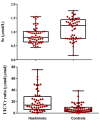Serum Selenium Status and Its Interrelationship with Serum Biomarkers of Thyroid Function and Antioxidant Defense in Hashimoto's Thyroiditis
- PMID: 33142736
- PMCID: PMC7692168
- DOI: 10.3390/antiox9111070
Serum Selenium Status and Its Interrelationship with Serum Biomarkers of Thyroid Function and Antioxidant Defense in Hashimoto's Thyroiditis
Abstract
Selenium (Se) deficiency has been implicated in the pathogenesis of Hashimoto's thyroiditis (HT), although the available evidence is limited. The present study aimed to explore the interrelationships between serum Se status with measures of thyroid function and antioxidant defense in new cases of HT patients with hypoechogenic thyroid. HT patients (n = 49) and matched controls (n = 50) were recruited. Selenium, thyroid hormone panel, thyroid volume (TVol), glutathione (GSH), glutathione peroxidase3 (GPx3) activity, urinary iodine concentration (UIC), and urinary creatinine (Cr) were assessed. HT patients exhibited lower Se levels compared to controls (p < 0.001) with the rates of Se-deficient (<0.85 µmol/L) participants being 58.8% and 34%, respectively. Se-deficient patients exhibited higher thyroid stimulating hormone (TSH), Thyroid volume (TVol), thyroglobulin, antibody-titers, GPx3 activity and UIC/Cr compared to Se-sufficient patients (all p < 0.001). In the Se-deficient patients, inverse correlations were seen between Se-levels with TSH, TVol, and Thyroid peroxidase antibody (TPO-Ab) (all p < 0.001). This study is the first to uncover that coexisting Se-deficiency and elevated iodine in HT may enhance autoimmune reactions and accelerate the deterioration of thyroid function through oxidative stress. Our study also highlights the importance of optimal Se status in this disease, thus providing a rationale for the execution of intervention trials for the evaluation of the clinical benefits of antioxidant-status improvement in HT.
Keywords: Hashimoto’s thyroiditis; glutathione; glutathione peroxidase; iodine; oxidative stress; selenium; thyroid hormones.
Conflict of interest statement
The authors declare no conflict of interest.
Figures



Similar articles
-
Enhanced oxidative stress in Hashimoto's thyroiditis: inter-relationships to biomarkers of thyroid function.Clin Biochem. 2013 Mar;46(4-5):308-12. doi: 10.1016/j.clinbiochem.2012.11.021. Epub 2012 Dec 4. Clin Biochem. 2013. PMID: 23219737
-
Multiple Nutritional Factors and the Risk of Hashimoto's Thyroiditis.Thyroid. 2017 May;27(5):597-610. doi: 10.1089/thy.2016.0635. Epub 2017 Apr 6. Thyroid. 2017. PMID: 28290237 Review.
-
Selenium and its relationship with selenoprotein P and glutathione peroxidase in children and adolescents with Hashimoto's thyroiditis and hypothyroidism.J Trace Elem Med Biol. 2016 Mar;34:10-4. doi: 10.1016/j.jtemb.2015.10.003. Epub 2015 Nov 18. J Trace Elem Med Biol. 2016. PMID: 26854239
-
Effect of selenium on thyroid autoimmunity and regulatory T cells in patients with Hashimoto's thyroiditis: A prospective randomized-controlled trial.Clin Transl Sci. 2021 Jul;14(4):1390-1402. doi: 10.1111/cts.12993. Epub 2021 Apr 9. Clin Transl Sci. 2021. PMID: 33650299 Free PMC article. Clinical Trial.
-
Hashimoto's thyroiditis and the role of selenium. Current concepts.Hell J Nucl Med. 2007 Jan-Apr;10(1):6-8. Hell J Nucl Med. 2007. PMID: 17450242 Review.
Cited by
-
Autoimmunity, New Potential Biomarkers and the Thyroid Gland-The Perspective of Hashimoto's Thyroiditis and Its Treatment.Int J Mol Sci. 2024 Apr 26;25(9):4703. doi: 10.3390/ijms25094703. Int J Mol Sci. 2024. PMID: 38731922 Free PMC article. Review.
-
Metabolic Characteristics of Hashimoto's Thyroiditis Patients and the Role of Microelements and Diet in the Disease Management-An Overview.Int J Mol Sci. 2022 Jun 13;23(12):6580. doi: 10.3390/ijms23126580. Int J Mol Sci. 2022. PMID: 35743024 Free PMC article. Review.
-
Persistent symptoms in euthyroid Hashimoto's thyroiditis: current hypotheses and emerging management strategies.Front Endocrinol (Lausanne). 2025 Jul 18;16:1627787. doi: 10.3389/fendo.2025.1627787. eCollection 2025. Front Endocrinol (Lausanne). 2025. PMID: 40756512 Free PMC article. Review.
-
The association between serum selenium levels and pathological features of papillary thyroid cancer in 284 patients.Front Endocrinol (Lausanne). 2023 Nov 3;14:1242250. doi: 10.3389/fendo.2023.1242250. eCollection 2023. Front Endocrinol (Lausanne). 2023. PMID: 38027150 Free PMC article.
-
Association between oxidative balance score and thyroid function and all-cause mortality in euthyroid adults.Sci Rep. 2025 Feb 25;15(1):6817. doi: 10.1038/s41598-025-90491-5. Sci Rep. 2025. PMID: 40000721 Free PMC article.
References
-
- Mazokopakis E.E., Chatzipavlidou V. Hashimoto’s thyroiditis and the role of selenium. Current concepts. Hell. J. Nucl. Med. 2007;10:6–8. - PubMed
Grants and funding
LinkOut - more resources
Full Text Sources
Miscellaneous

